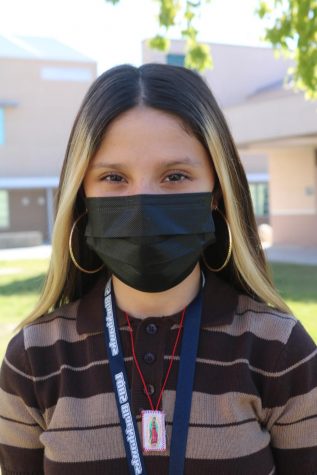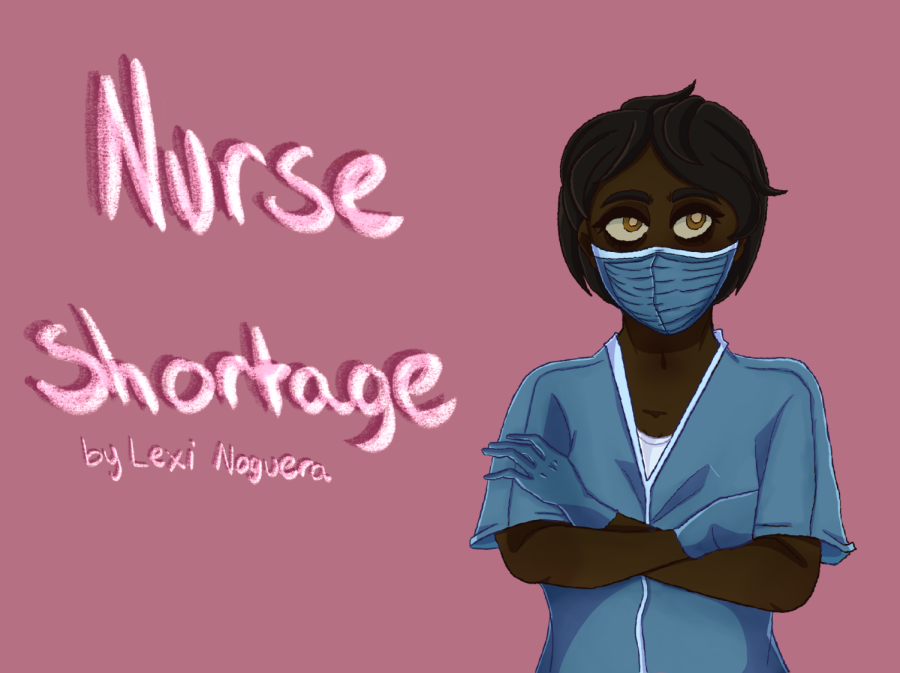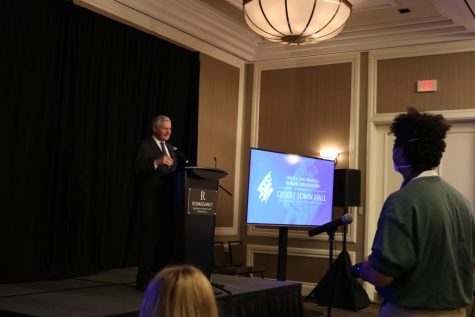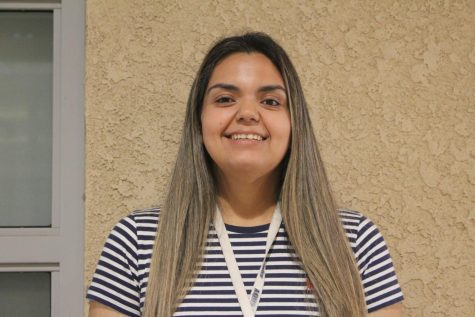“Nurses are being overworked”: A local look inside the front lines of the pandemic
Almost anything when it comes to the medical field has been in a shortage since the beginning of the COVID-19 pandemic from hand sanitizer to nurses.
Due to COVID-19, the ratio of patients to nurses has seemed to increase as there are way more patients than nurses.
“Typically, with all of us being staffed, for each nurse, we can see maybe 10 [patients] a day which doesn’t sound too bad but with everything that’s been going on, I’ve been seeing almost 20 which is a big difference,” Corinna Perez said, a registered nurse.
Perez is an RN who works at a medical center in Rancho Mirage, Calif. At her office, she is currently experiencing a shortage of staff while having to manage more patients than before.
“My boss and I were the only nurses available for over 60 some patients,” she said. “Recently we’ve been short a nurse almost every week for the past month and a half.”
Nurses have had to adapt to do more work within the same amount of hours they work every day.
With so much to do, nurses spend less time focusing on one task in order to finish all their tasks and help as many patients as they can in a day, Perez said.
“There’s phone calls coming through, there’s doctors giving us orders. There’s a lot of things going on all at once. Being short-handed, you don’t have all that time to spend with that one patient to hear them out and see what you have to do for them. You pretty much do the very best you can,” she said.
Frustration naturally occurs within patients who just want to be treated, but don’t understand the issue of there not being enough nurses to treat them right away.
Perez had a patient scheduled for 11:45 a.m. for treatment but wasn’t able to get to her until about three hours later.
“Nurses get sick too, and I had to explain to [the patient] that we are short [staffed]. It was just two nurses, she wasn’t the only patient so we couldn’t treat her. She was upset and we couldn’t treat her until the next day,” she said.
Perez feels that it’s important for patients to understand that things aren’t perfect and that it’s not the nurses’ fault that they aren’t able to reach appointments so quickly.
“There’s not enough help, you want to give all the attention to that one patient and everything they need to help them get through. You don’t have the time for them and it just makes it much harder,” she said.
Perez said that through the nurse shortages, she believes a major cause of this shortage is nurses having to quit their job because of a vaccine mandate given by the government for public workers.
The government’s mandate of the COVID-19 vaccine to healthcare workers plays a big role in the choice of healthcare professionals.
“Even nurses are not comfortable with their own personal reasons, which has forced them to resign their job to get another profession,” she said.
“It’s pretty sad,” she said. While nurses do have to face years of education only to have to give up their job because of their personal choice of not getting the COVID-19 vaccination.
With so much pressure on her back, Perez has felt that she’s sadder than she usually gets through these exhausting times.
“I feel like sometimes I don’t have any more patience. I feel sad and very exhausted mentally and emotionally. I feel drained,” she said.
Perez has questioned whether she’s chosen the right profession or if she should have chosen a different path. She reassures herself that being a nurse is a “beautiful profession” because nursing has so many roles in one and creates such a unique job.
“It makes me sad to see what it’s come to. I think for the most part it’s affected everyone,” she said. “All healthcare workers and especially nurses.”
Analisa Pittenger is an outpatient of women’s health and does PCR COVID testing at Eisenhower in Rancho Mirage and shares her experience of the nurse shortage and how it affects her job at the hospital.
Pittenger is now an outpatient nurse who takes care of patients who don’t have to stay overnight at a hospital and they’re able to leave that same day.
“My ratio was two patients to one nurse and most of the time they tried to stay within that ratio so California state health ratios were depending on what area the hospital you’re in and what type of patients you’re taking,” she said.
Pittenger explains the normal ratio of nurses to patients depends on the circumstances of that nurses’ position, but recently it hasn’t been easy trying to keep up with the average standard of ratios. Instead, hospitals request waivers allowed by the state to step outside of the ratio from nurses to patients.
“As much as the hospitals tried to keep nurses in ratio. It was physically impossible because the number of patients far exceeded the amount of nursing staff that was available,” she said. “Instead of taking care of four patients, now [the nurses] are taking care of seven patients or instead of two ICU patients it’s now three or four.”
With such a small number of nurses and a large number of patients, nurses have to adapt to do more work within the same amount of hours they work a day.
Pittenger feels tired because she feels she’s in “a never-ending fight” causing her to feel mentally exhausted after working in extreme conditions for quite a bit of time.
“It’s fine to work under extreme circumstances for a short amount of time, but now we’re going two years doing this and it’s a little bit overwhelming,” she said.
Under those extreme circumstances, the same hour shift is being worked. Though with the nurse shortage, it appears to make the pace go by faster for nurses because they have fewer nurses to complete more tasks.
“You have to wait to chart until the end of the day because you’re just constantly doing tasks. You’re passing meds, taking care of patients, and doing normal everyday stuff. Then you have to charge all those details later because you don’t have time to chart them during normal shifts,” she said.
Every day, nurses must chart down their tasks to record what they did on a daily basis.
Pittenger feels that nurses are working too much, which is a huge part of what causes the shortage because nurses want to step down from their current position or just retire.
“I think nurses are being overworked, they’re dying and nurses are retiring or moving to an outpatient nurse or not working with directly sick patients,” she said.
Pittenger explained the process of what a nurse needs to follow in order to be in the same room with a patient who has tested positive for COVID-19
“While you’re in there, you’re doing a lot of work completely gowned up. You get hot, sweaty, fatigued, and overwhelmed,” she said.
Pittenger is one of the nurses who transferred as an outpatient nurse. Before she was doing bedside nursing until recently she decided to find a calmer solution to her stress.
“I’m fatigued, I think that’s why I stepped away from bedside nursing and went to an outpatient world because I’m tired,” she said.
Due to the shortage, Pittenger has noticed more travel nurses are temporary nurses which bring in extra help.
“I do notice [that there are fewer nurses] because we have more travel nurses who just travel and aren’t full-time nurses but they bring in extra help,” she said.
A travel nurse is a nurse who travels to different offices or hospitals for a short amount of time due to not having enough staff or that hospital might need extra help.
Rachel Morgan is a travel nurse who has experienced a great challenge since the beginning of the pandemic due to more offices being short-staffed. Since the start, she’s been traveling to different locations.
“Right now, I’m working in Lancaster, Oxnard, Glendora, and Pasadena. Sometimes I do the Rancho Mirage office,” she said.
When traveling to new places so quickly, it can be a challenge because Morgan has to learn how to adapt to the environment and the policies they give.
“It’s hard because…each office has different policies for how to handle patient care,” she said. “It’s not all the same.”
Along with being short-staffed, it’s important for Morgan to watch herself carefully while caring for so many patients.
“I have a lot of patients and I’m by myself so it’s really a challenge because when you have too many patients and not enough help, you could potentially make mistakes. You have to be extra careful because when you rush, you could miss something or make a mistake,” she said.
Since the shortage, Morgan feels that she’s worked a lot harder than she used to since she has to manage her school life, work-life and personal life.
“I’m doing a lot more work than I used to and it’s so tiring. It’s exhausting and sometimes I feel burnt out, you know,” she said.
While the number of nurses decreased, Morgan noticed that the number of patients grew because of lockdown when they never went to the doctor and didn’t get the care they needed.
“People didn’t really go to the doctor [during lockdown], so that was a whole solid year of people not getting proper care and so now people are really sick,” she said.
With more patients needing help and fewer nurses available, nurses can get really overwhelmed with working more than they used to and leading to burnout.
Digging in deeper, Morgan notices the delays in people who were graduating from nursing schools since the pandemic pushed many events back. Even the nurses who did graduate during the pandemic, they didn’t get to have hands-on learning like classes in the past.
“It’s difficult to try and hire them because a lot of the students had virtual clinicals so they don’t actually have hands-on experience,” she said.
While having to hire these nurses, Morgan also has to teach them how to be a nurse as well as already training them but struggles to find the time to do so.
“I’ve hired a bunch of nurses and they’ve never even started an IV, so that’s a big challenge there,” she said.
The number of patients Morgan sees a day depends on the office she’s at, but during her experience of the nurse shortage, the most patients she’s seen by herself is between 20 to 23.
“When I work in Glendora, I’ve seen about 25 patients a day but Pasadena is pretty small so I don’t see too many patients there, maybe five or six patients at the most,” she said.
With the high ratio of nurses to patients, nurses are now putting their foot down into lowering or having a more safe ratio from nurses to patients.
“Nurses are now wanting the state to start mandating safer ratios,” Morgan said.
This way it is safer for nurses to focus on fewer patients for a longer amount of time rather than rushing to help so many patients at once.
“There’s too many patients to one nurse, so they’re trying to limit the numbers so that it’s safer. They [the nurses] can administer medications and properly care for patients with a safe number of patients to one nurse,” she said.
After two years of an overwhelming pandemic for anyone in the medical field, Morgan feels nurses will search for new careers outside the medical field, or other nurses could burn out and retire too soon.
“Much more new nurses will burnout and old nurses burnout because you need plenty of new nurses moving into the field and you need plenty of nurses that are seasoned and well experienced to help train and teach younger nurses,” she said.
With there always being a light at the end of a tunnel, Morgan hopes that this shortage will help bring more nurses together to help each other become stronger and improve their skills in the unique and diverse profession of nursing in the medical field.
“I hope that this shortage helps nurses that have been around awhile to really help those younger nurses become strong,” she said.
“Help them [younger nurses] grow and they [older nurses] don’t chew them up. I hope that traditions kind of stopped and I think it’ll help the profession altogether and work more as a team rather than a race. It just really builds more of a teamwork environment.”

Lexi Noguera was editor-in-chief for the 2022-2023 school year. She was a fourth-year Hawkview journalist. She is a proud Chicana, cat lover, a Gemini, and a raging Dodgers fan.

Maddison Ayala was a senior and a first year-journalist who graduated in 2022. She was an artist who dabbled in graphic design as well as poetry. She cared about her loved ones and her cat, Baby. She achieved the ability to draw anatomy (kinda) She did her best. Please be patient with her.








laly ♦ Mar 28, 2022 at 8:39 pm
YES!!! so good lexi!! <3